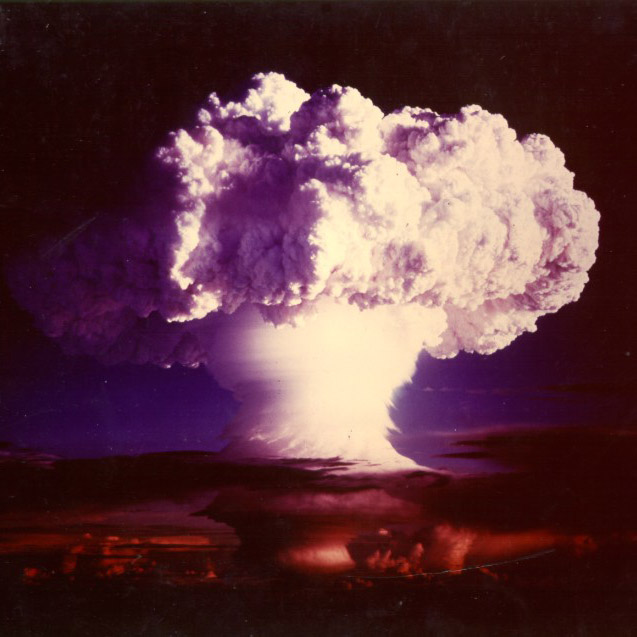Ejnŝtejnio
99
Es
Grupo
Neniu
Perio
7
Bloko
f
Protonoj
Elektronoj
Neŭtronoj
99
99
153
Ĝeneralaj Propraĵoj
Atoma Nombro
99
Atommaso
[252]
Amasa Nombro
252
Kategorio
Aktinoidoj
Koloro
Neniu
Radioaktiva
Jes
Named after Albert Einstein
Kristala Strukturo
Neniu
Historio
Einsteinium was discovered as a component of the debris of the first hydrogen bomb explosion in 1952.
It was identified by Albert Ghiorso and co-workers at the University of California, Berkeley in collaboration with the Argonne and Los Alamos National Laboratories, in the fallout from the Ivy Mike nuclear test.
The new element was produced by the nuclear explosion in miniscule amounts by the addition of 15 neutrons to uranium-238.
It was identified by Albert Ghiorso and co-workers at the University of California, Berkeley in collaboration with the Argonne and Los Alamos National Laboratories, in the fallout from the Ivy Mike nuclear test.
The new element was produced by the nuclear explosion in miniscule amounts by the addition of 15 neutrons to uranium-238.
Elektronoj per ŝelo
2, 8, 18, 32, 29, 8, 2
Elektrona Agordo
[Rn] 5f11 7s2
Einsteinium is the first divalent metal in the actinide series
Fizikaj Propraĵoj
Fazo
Solido
Denso
8,84 g/cm3
Fandpunkto
1133,15 K | 860 °C | 1580 °F
Bolpunkto
-
Varmo de Fuzio
Neniu kJ/mol
Varmo de Vaporiĝo
Neniu kJ/mol
Specifa Varmo Kapacito
- J/g·K
Krusta Abundo
Neniu
Universa Abundo
Neniu

Bildaj kreditoj: Wikimedia Commons (National Nuclear Security Administration)
Einsteinium was first observed in the fallout from the Ivy Mike nuclear test
CAS Nombro
7429-92-7
PubChem Kunmetita Identiga Nombro
Neniu
Atomaj Propraĵoj
Atoma Radiuso
-
Kovalenta Radiuso
-
Elektronegativeco
1,3 (Pauling-skalo)
Potencialo de jonigo
6,42 eV
Atoma Volumo
28,5 cm3/mol
Termika Kondukto
0,1 W/cm·K
Oksidaj Ŝtatoj
2, 3
Aplikoj
Einsteinium is mainly used for scientific research purposes.
The rare isotope einsteinium-254 is favored for production of ultraheavy elements.
Einsteinium-254 was used as the calibration marker in the chemical analysis spectrometer of the Surveyor 5 lunar probe.
The rare isotope einsteinium-254 is favored for production of ultraheavy elements.
Einsteinium-254 was used as the calibration marker in the chemical analysis spectrometer of the Surveyor 5 lunar probe.
Einsteinium is harmful due to its radioactivity
Izotopoj
Stabilaj Izotopoj
-Malstabilaj Isotopoj
240Es, 241Es, 242Es, 243Es, 244Es, 245Es, 246Es, 247Es, 248Es, 249Es, 250Es, 251Es, 252Es, 253Es, 254Es, 255Es, 256Es, 257Es, 258Es